To view previous releases, select one from the dropdown box:
Currently displaying information released on: July, 2024
EU AND EURO AREA CONSUMER PRICE INDEX, JUNE 2024
Year-over-year (June 2024 vs June 2023)
The inflation rate slowed to 2.6% in the European Union and to 2.5% in the Euro Area in June 2024.
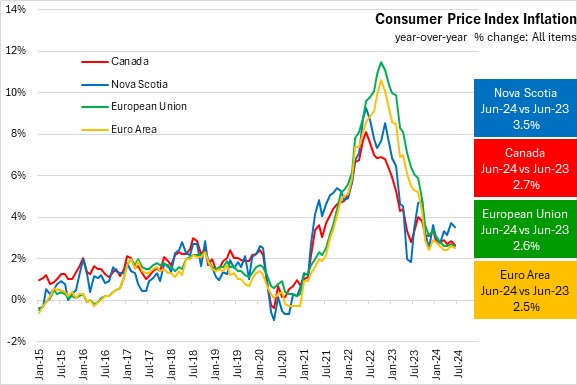
The fastest inflation was reported in Belgium and Romania while the slowest inflation rates were in Finland, Italy, and Lithuania.
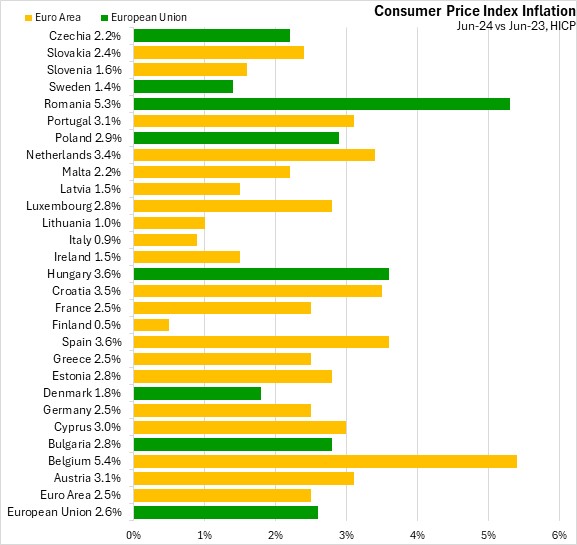
Energy prices rose 0.2% both in the European Union and Euro Area in June 2024.
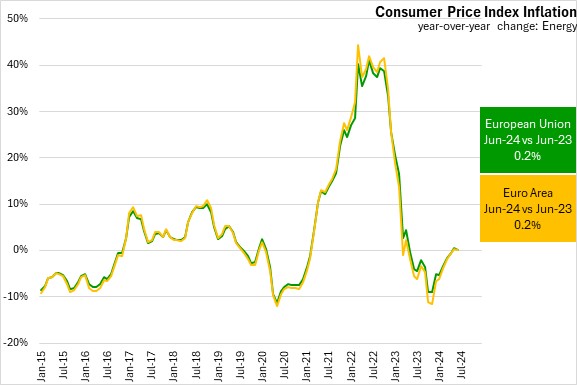
Food price inflation has continued to slow to 1.3% for the European Union and 1.6% in the Euro Area in June 2024.
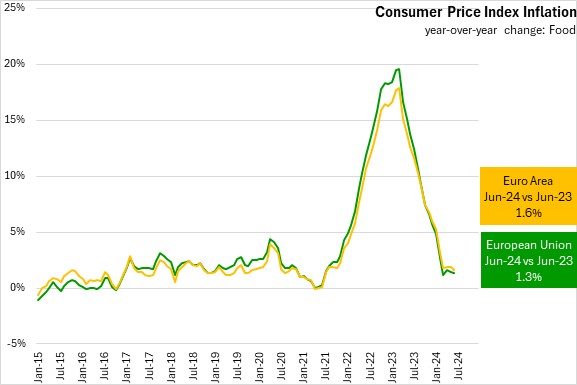
Excluding the impacts of energy, food, alcohol and tobacco prices year-over-year inflation slowed to 3.1% in the European Union and to 2.9% in the Euro Area in June 2024.
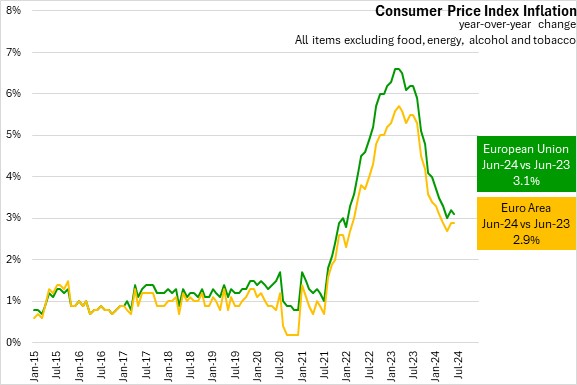
Source: Eurostat; Eurostat Data CONSUMER PRICE INDEX, JUNE 2024
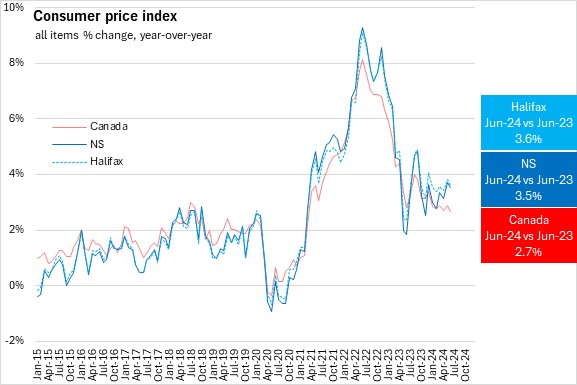
Year-over-year (June 2024 vs June 2023)
All items: Consumer prices in Nova Scotia increased 3.5%. The national average inflation was 2.7%. In Halifax consumer prices increased 3.6%.
All items excluding food and energy: Nova Scotia consumer prices outside of food and energy increased 2.5%. This was below the national average increase of 2.9%.
Month-over-month (June 2024 vs May 2024)
All items: Consumer prices in Nova Scotia increased 0.2%. Nationally, consumer prices decreased 0.1% compared to the previous month. In Halifax consumer prices rose 0.3%.
All items excluding food and energy: Nova Scotia consumer prices excluding food and energy grew 0.5% month over month in June 2024. Nationally, consumer prices outside of food and energy were unchanged from the previous month.
Source: Statistics Canada. Table 18-10-0004-01 Consumer Price Index, monthly, not seasonally adjusted ANALYSIS OF CONSUMER PRICE INDEX FOR JUNE 2024
Nova Scotia’s all items Consumer Price Index (CPI) slowed to 3.5% year-over-year in June 2024, down from 3.7% year-over-year in May. This was the fastest year-over-year pace of price growth across provinces.
Nova Scotia's inflation has been slowing after peaking at 9.3% in June 2022, though there have been periods of rising inflation, particularly on higher energy prices.
Nationally, consumer prices increased 2.7% year-over-year in June 2024, down from 2.9% in May. Inflation was highest in Nova Scotia and slowest in Manitoba and Saskatchewan.
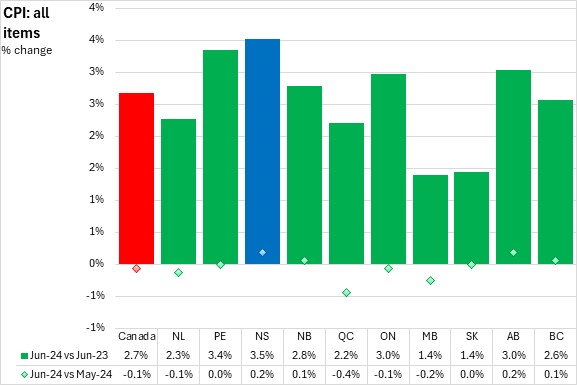
The most significant upward contributors (combining price increase as well as share of the consumption basket) to Nova Scotia's 3.5% year-over-year inflation were: gasoline, mortgage interest cost, rent, food purchased from restaurants, and fuel oil.
The largest downward year-over-year contributions were from: telephone services, recreational equipment and services (excluding RVs), home entertainment equipment/parts/services, children’s clothing, and traveller accommodation.
On a monthly basis, Nova Scotia's all items CPI was up 0.2% from May to June 2024. National prices were down 0.1% with increases reported for four provinces. Nova Scotia and Alberta reported the fastest percentage growth on a monthly basis. The largest monthly decline was in Québec. Prince Edward Island and Saskatchewan prices for all items were unchanged.
Major upward contributors to Nova Scotia's monthly consumer prices were: rent, traveller accommodation, inter-city transportation, passenger vehicle insurance premiums, and food purchased from restaurants. The main downward contributions were from: gasoline, personal care supplies/equipment, purchase/leasing of passenger vehicles, fuel oil, and purchase/operation of recreational vehicles.
Energy prices play a significant role in inflation rates. Nova Scotia's energy prices were up 11.0% from June 2023 to June 2024. Year-over-year energy prices were up 0.5% nationally with six provinces reporting higher energy prices. Nova Scotia reported the fastest year-over-year growth in energy prices while Manitoba reported the largest decline.
On a monthly basis, Nova Scotia's energy prices declined 2.9% from May to June 2024. National energy prices were down 2.1% with all provinces reporting lower prices compared to the previous month. British Columbia reported the largest monthly decline in energy prices.
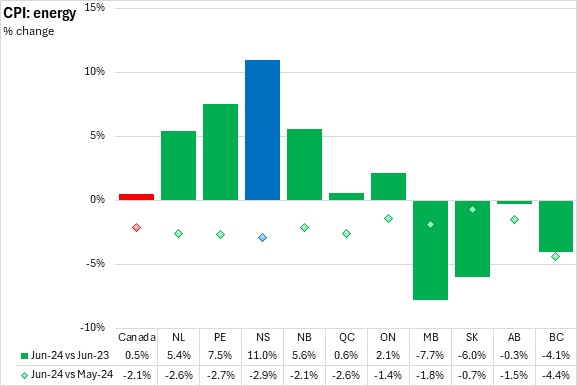
Nova Scotia's energy prices (and overall inflation) are more sensitive to fluctuations in the global price of crude oil. In June 2024, gasoline prices increased 11.9% compared to a year ago in Nova Scotia. Six provinces reported higher gasoline prices, with the fastest growth in Nova Scotia. Manitoba reported the steepest drop in gasoline prices. Gasoline prices declined 4.6% from May to June in Nova Scotia (-3.1% nationally). All provinces reported monthly gasoline price declines with the largest decline in British Columbia.
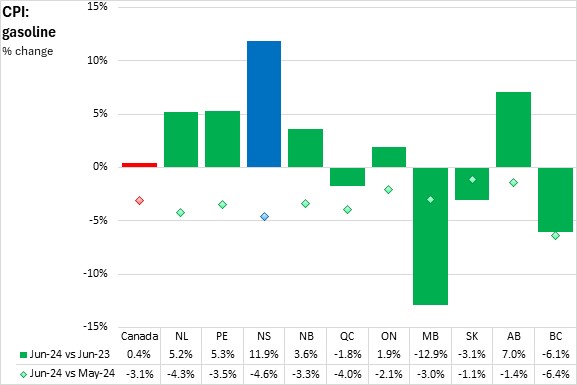
Nova Scotia's year-over-year inflation for fuel oil was 17.6%, the third fastest growth among provinces. Nationally, the fuel oil and other fuels index increased 10.5% compared to June 2023. On a monthly basis, Nova Scotia's fuel oil prices were down 1.4%. National fuel oil prices were down 2.1% from May to June. Saskatchewan reported the fastest growth and Ontario reported the largest decline.
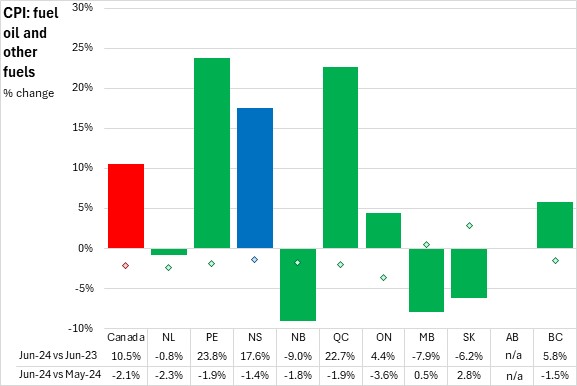
Food price inflation was 3.8% in Nova Scotia (June 2024 vs June 2023). National food prices increased 2.8% in June. Food prices were up in all provinces. Prince Edward Island reported the highest food price inflation while Québec reported the slowest food price growth.
On a monthly basis, Nova Scotia's food prices increased 0.7% from May to June. National food prices rose 0.5% with all provinces (except Québec) reporting higher prices on a monthly basis. The fastest growth was in Prince Edward Island.
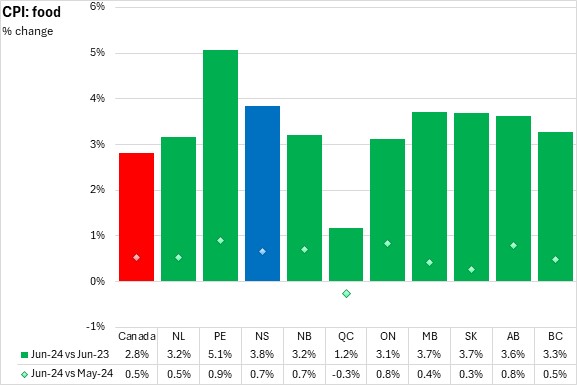
Food and energy prices are heavily influenced by volatile global commodity markets. Nova Scotia's underlying inflation rate excluding food and energy was 2.5% from June 2023 to June 2024. Nationally, inflation excluding food and energy was 2.9%. Alberta reported the fastest growth while Newfoundland and Labrador and Manitoba reported the slowest growth in inflation excluding food and energy prices.
On a monthly basis, Nova Scotia's prices for all items excluding food and energy were up 0.5% from May to June 2024. Nationally, prices for all items excluding food and energy were unchanged with increases in seven provinces. Nova Scotia reported the fastest monthly increase while Manitoba reported the largest monthly decline.
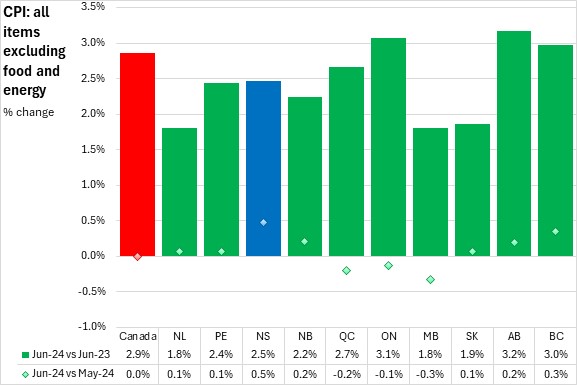
Year-over-year shelter cost inflation was 6.3% in Nova Scotia in June 2024, slightly below the 6.4% shelter inflation reported in May. National shelter prices were up 6.2% with increases in all provinces. Alberta reported the largest year-over-year increase in shelter prices while Saskatchewan reported the slowest increase.
Monthly shelter costs were up 0.8% in Nova Scotia from May to June 2024, the largest monthly increase among provinces. Nationally, shelter costs were up 0.3% with increases in all provinces except Prince Edward Island.
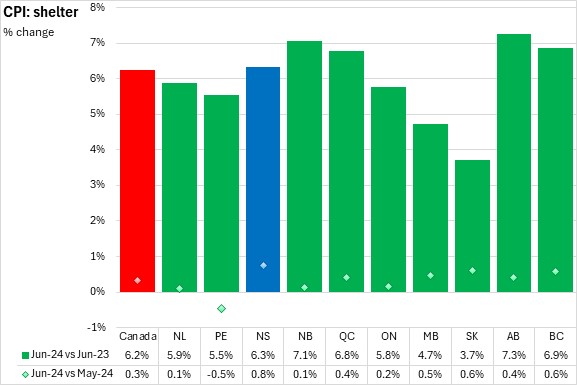
Among detailed food products with available data, Nova Scotia's year-over-year inflation was fastest for preserved fruit as well as beef and sugar and confectionary. The largest year-over-year price decline was for fish/seafood.
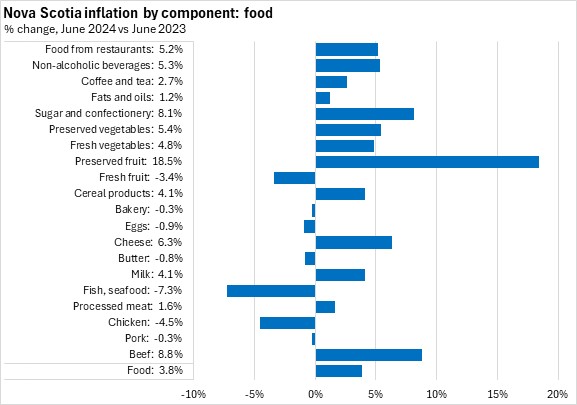
In detailed shelter cost components, fuel oil reported the fastest year-over-year price increase, followed by rent. Homeowners replacement cost reported the slowest year-over-year increase.
Household operations/furnishings costs were up 0.5% overall. The largest increase was for internet access services. Prices fell for telephones, paper/plastic/aluminium products as well as for textiles, appliances, and utensils/tableware/cookware.
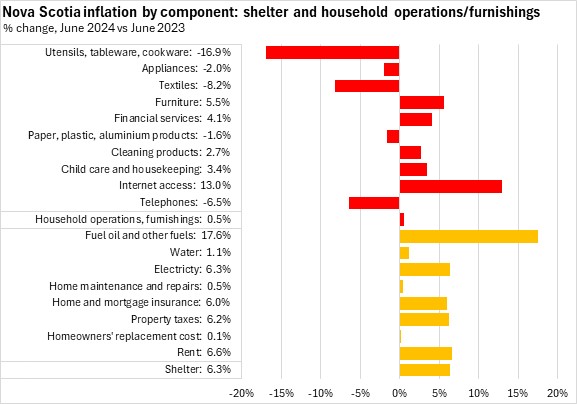
Clothing and footwear prices were down 5.0% year-over-year in June with declines in all sub-components except clothing accessories and jewellery and clothing materials and services.
Health and personal care costs were up 2.1% year-over-year on gains in all sub-components (except personal care supplies) led by personal care services.
Overall transportations costs were up 4.6% year-over-year in June. City busses had the only decline while gasoline had the largest increase.
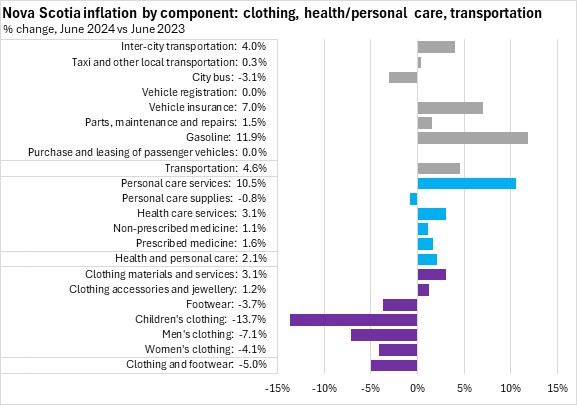
Nova Scotia's overall prices for recreation, education and reading were up 1.7% from June 2023 to June 2024, with faster increases for travel services and accommodations. Prices declined the fastest for home entertainment equipment/services compared to June 2023.
Nova Scotia's prices for alcohol, tobacco and recreational cannabis were up 3.9% year-over-year with growth in all categories. Alcohol from licensed establishments had the largest increase, followed by cigarettes.
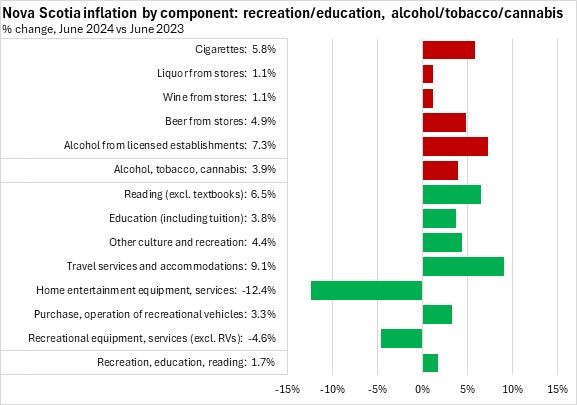
Trends
Since the start of the Bank of Canada's inflation-targeting monetary policy regime, inflation for all items has generally been in the 0-4% range. Periods of above target inflation are typically followed by periods of slow price growth or declines. The most recent acceleration in inflation was the strongest since the inflation-targeting era began, though this inflation has faded with tighter monetary policy and lower commodity prices.
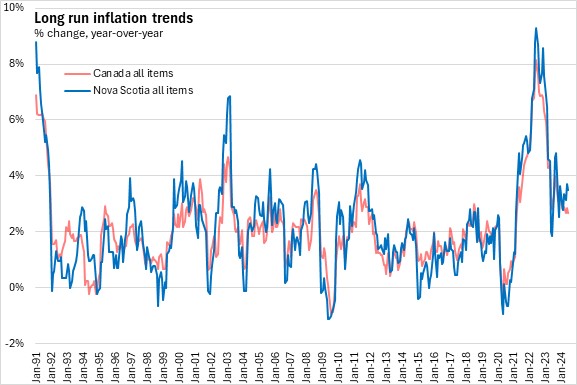
Many of these periods of accelerated and slowed inflation are attributable to volatile commodity prices, especially energy prices. Once the more volatile commodity prices are excluded, inflation in Nova Scotia has largely been below 2% for much of the last 20 years. However, the recent rise in inflation through 2021-2023 spreads beyond commodity prices, resulting in the longest period under the Bank of Canada's inflation-targeting regime with Nova Scotia's CPI excluding food and energy above 3%. In the last six months, Nova Scotia's inflation excluding food and energy has slowed to less than 3% year-over-year.
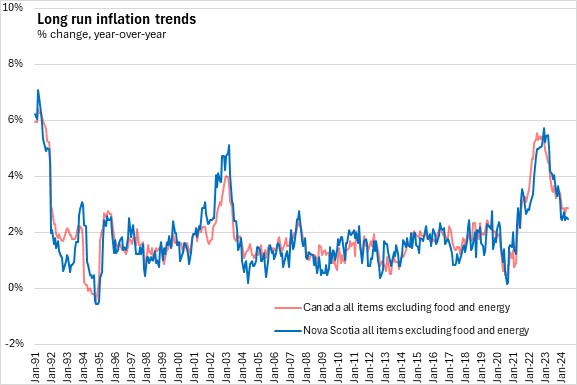
The Bank of Canada examines 'core' measures of inflation that are intended to remove the effects of volatile components and capture underlying inflation trends that are more connected to capacity in the Canadian economy. Core measures of inflation may also indicate where all items inflation is headed.
Canada's core measures of inflation remained mostly at or below the Bank's target of 2% for over a decade prior to 2021. However, after prices accelerated in 2022, core inflation measures also started to rise, peaking at over 6% for the CPI-common measure before declining. Compared to the previous month, year-over-year core inflation measures in June 2024 were down for CPI-common and CPI-median while up for CPI-core and CPI-trim unchanged: CPI-common (2.3%), CPI-median (2.6%), CPI-trim (2.9%), CPI-core (1.9%).
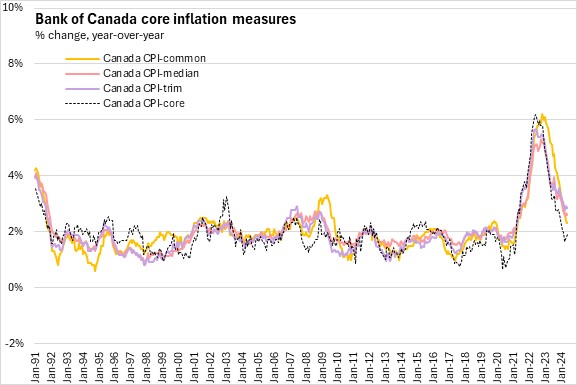
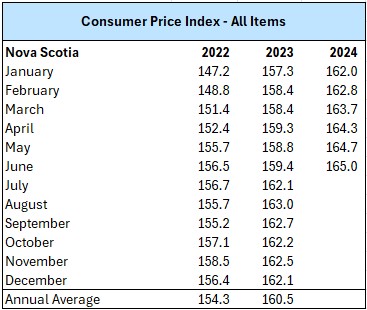
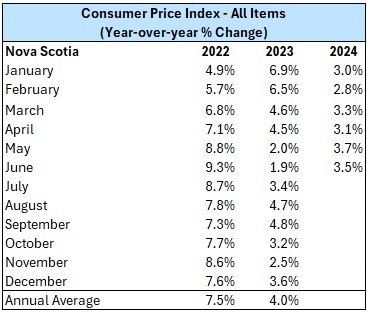
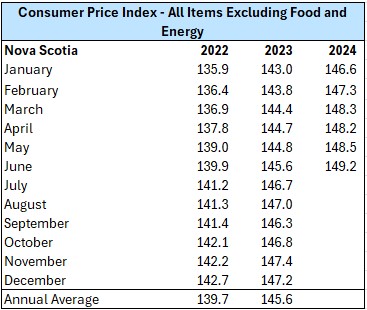
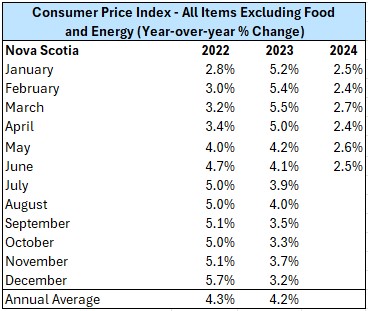
 Source: Statistics Canada. Table 18-10-0004-01 Consumer Price Index, monthly, not seasonally adjusted; Table 18-10-0256-01 Consumer Price Index (CPI) statistics, measures of core inflation and other related statistics - Bank of Canada definitions Source: Statistics Canada. Table 18-10-0004-01 Consumer Price Index, monthly, not seasonally adjusted; Table 18-10-0256-01 Consumer Price Index (CPI) statistics, measures of core inflation and other related statistics - Bank of Canada definitions
US CONSUMER PRICE INDEX, JUNE 2024
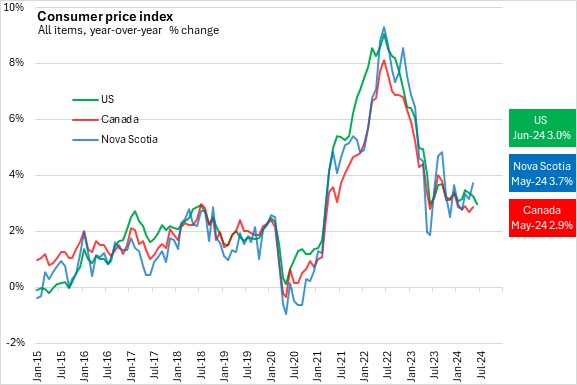 
The United States Consumer Price Index (not seasonally adjusted) for All Urban Consumers increased 3.0% year-over-year in June 2024, this was down from a year-over-year pace of 3.3% in May.
Compared to June 2023, the US energy price index rose 1.0%. The food index rose 2.2% and the shelter index was up 5.2% year-over-year.
The US CPI excluding food and energy rose 3.3% compared to June 2023.
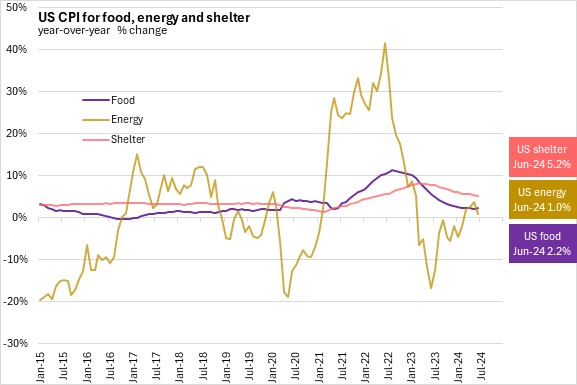
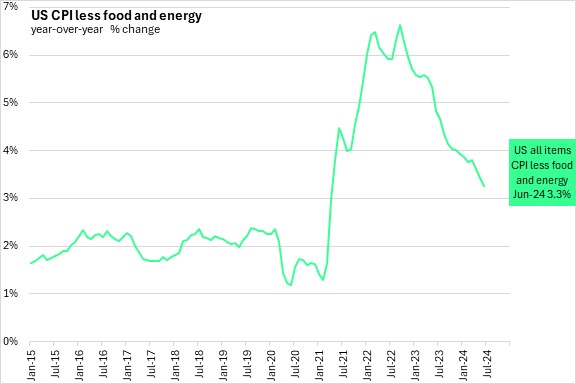
Note: Canada and Nova Scotia June 2024 CPI figures will be released on July 16, 2024.
Sources: Statistics Canada. Table 18-10-0004-01 Consumer Price Index, monthly, not seasonally adjusted; US Bureau of Labor Statistics retrieved from the Federal Reserve Bank of St. Louis AVERAGE RETAIL PRICES, MAY 2024
Statistics Canada makes available scanner data on prices collected for a range of food and personal care items. These prices are collected through point-of-sale (transaction) data obtained directly from Canadian retailers. The data represent commonly purchased items (which do change over time), but are not representative of the Consumer Price Index weights. Over time, products are rotated and quantity or quality may change. Comparisons of prices from one time period to another may reflect quantity and quality changes as well as price changes.
For the purposes of this analysis, the 110 items reported by Statistics Canada will be grouped into:
- Meat, fish, poultry and meat substitutes
- Dairy, eggs and substitute products
- Fruit (including canned and frozen products)
- Vegetables (including canned and frozen products)
- Grains, cereals, beans, legumes and nuts
- Sugar, juices, cooking oils, condiments and prepared foods
- Health and cleaning products
Beef and salmon are the most expensive of meat and seafood products. Several meat and substitute products in Nova Scotia were more expensive than the national average in May: meatless burgers, canned tuna, bacon, chicken breasts, whole chicken, pork rib cuts, ground beef and top sirloin cuts of beef.
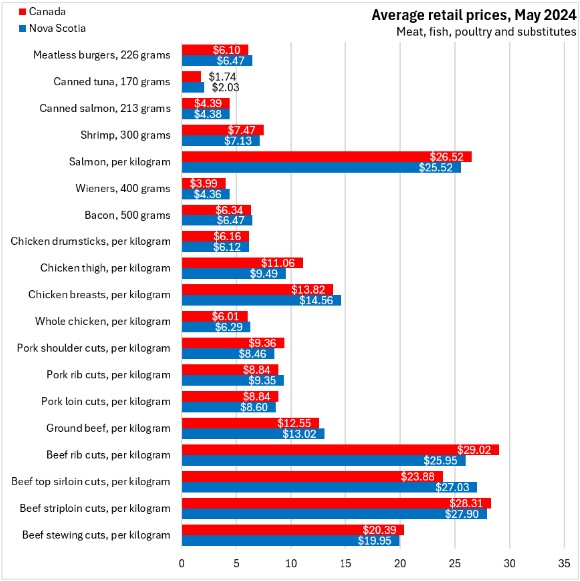
Over the last year (May 2024 vs May 2023), the consumer price index for all items in Nova Scotia excluding food increased by 3.9%. At the same time average weekly earnings across all Nova Scotia industries increased by 8.2%.
Prices for many meat, seafood and substitute products have grown faster than average weekly earnings over the last year. However, seafood, bacon, weiners, chicken drumsticks and pork loin cuts all reported lower prices in May 2024 than in May 2023.
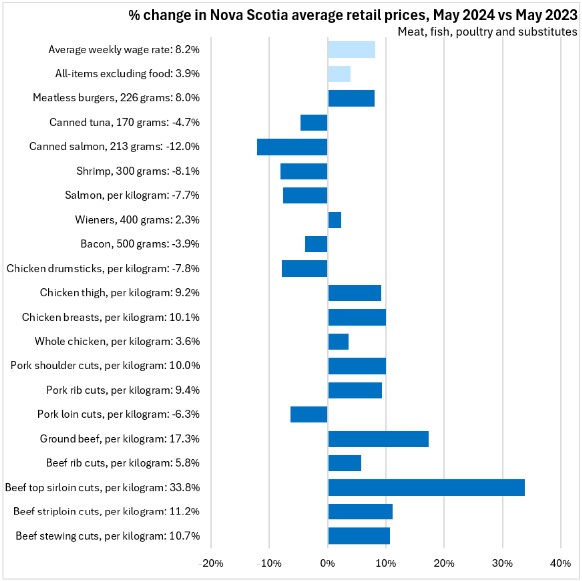
Food prices have been distorted in recent years by global market conditions following the pandemic and Russia's invasion of Ukraine. Compared with May 2019, prices for most meat products have grown faster than average weekly earnings in Nova Scotia. The exceptions were: meatless burgers, seafood, bacon, chicken drumsticks, pork (shoulder and loin cuts) and beef ribs.
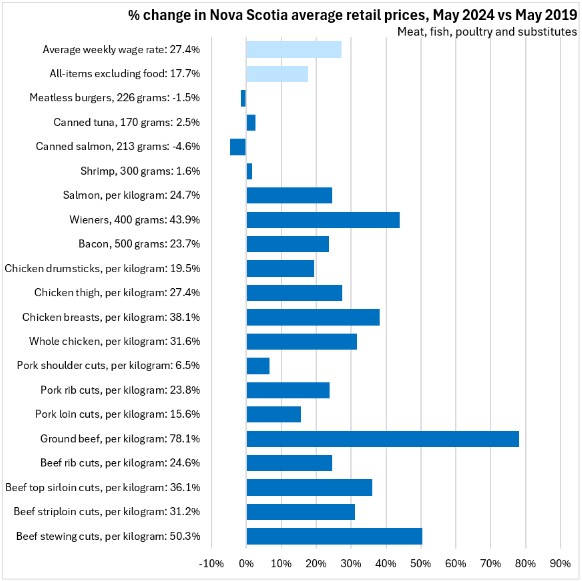
Dairy and egg prices were generally higher than the national average in Nova Scotia in May 2024 (exceptions: butter, soy milk, milk in 2 litre containers).
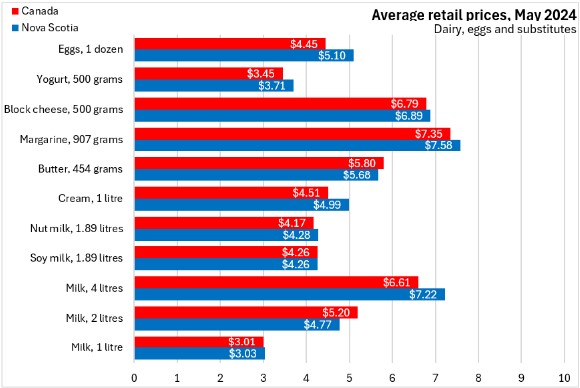
Compared with May 2023, reported dairy and egg prices have all grown more slowly than average weekly earnings. Some products have reported year-over-year declines in prices: eggs, butter, cream, nut milk, soy milk.
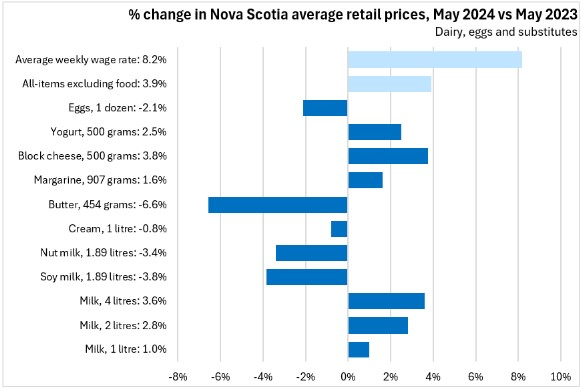
Over the last 5 years, the prices of eggs, margarine, butter and milk in 4 litre containers have all grown faster than average weekly earnings.
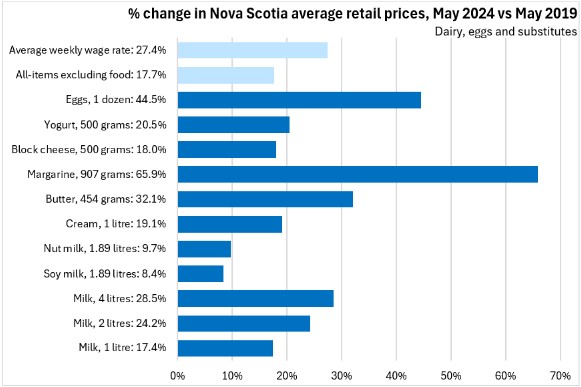
Prices for reported fruits in Nova Scotia were all higher than the national average for similar products. The largest gaps (in percentage terms) were for limes, bananas, strawberries and cantaloupes.
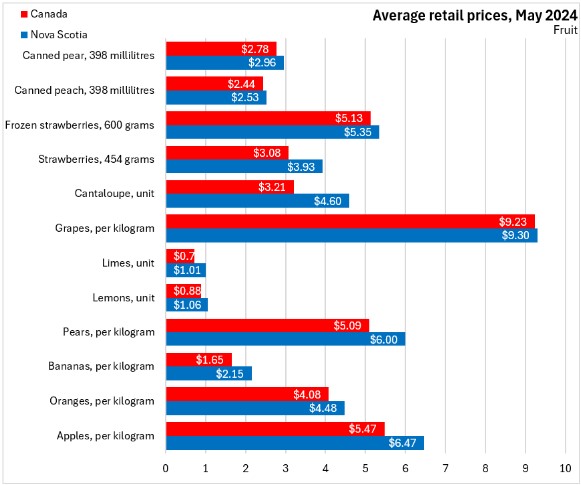
Many fruit prices have fallen in the last year and average weekly wage growth has outpaced all reported fruits.
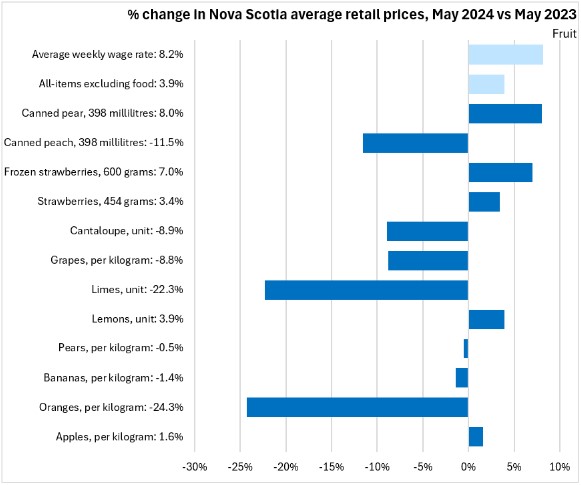
Over the last 5 years, most reported fruit prices have not grown as quickly as average weekly earnings (exceptions: cantaloupe, canned pears, grapes).
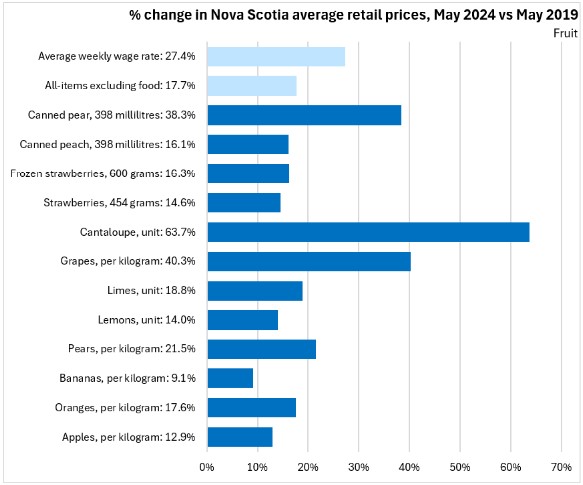
Almost all reported vegetable prices were higher in Nova Scotia than the national average in May 2024 (exceptions: salad greens, avocados). In percentage terms, the largest gap was for broccoli.
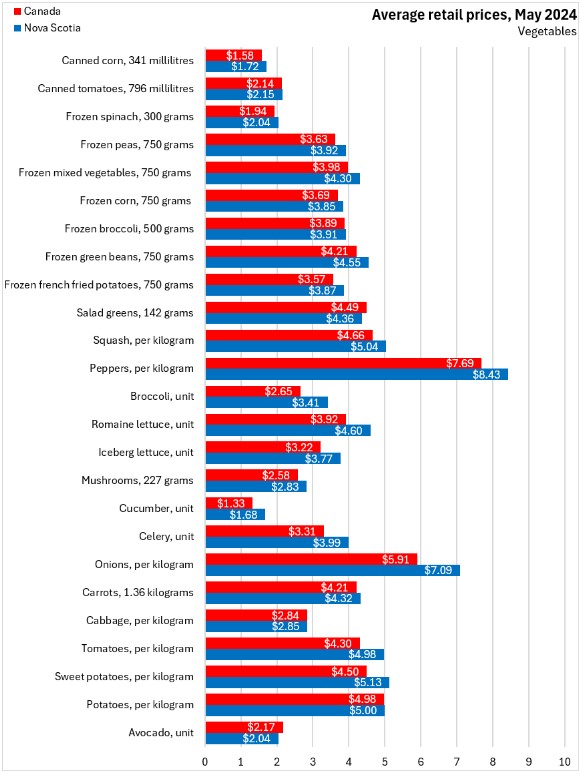
Average weekly wage growth from May 2023 to May 2024 has outpaced price increases for most reported vegetables (exceptions: canned corn, frozen french fries, romaine lettuce, onions, carrots, sweet potatoes, avocados). Several vegetable products reported lower prices over the last year, led by squash, frozen spinach and broccoli.
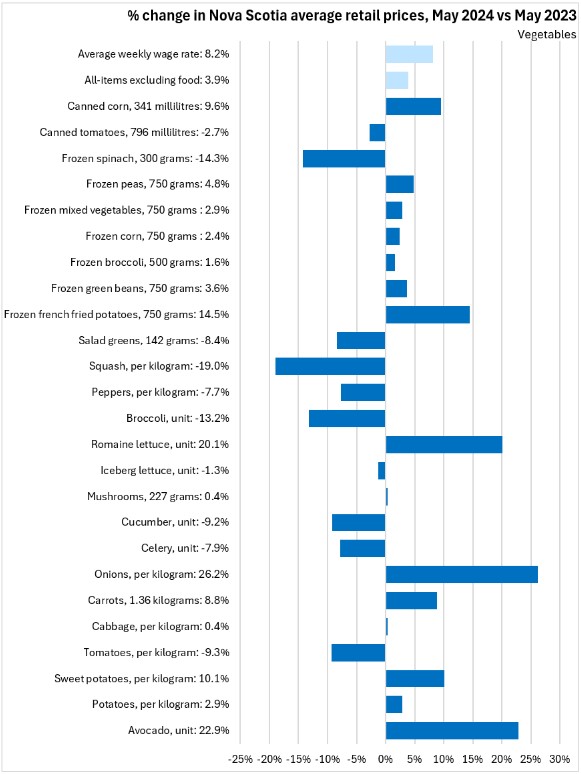
Over the last 5 years, vegetable prices have outpaced wage growth for the following products: canned corn, canned tomatoes, frozen french fries, lettuce (both romaine and iceberg), mushrooms and onions.
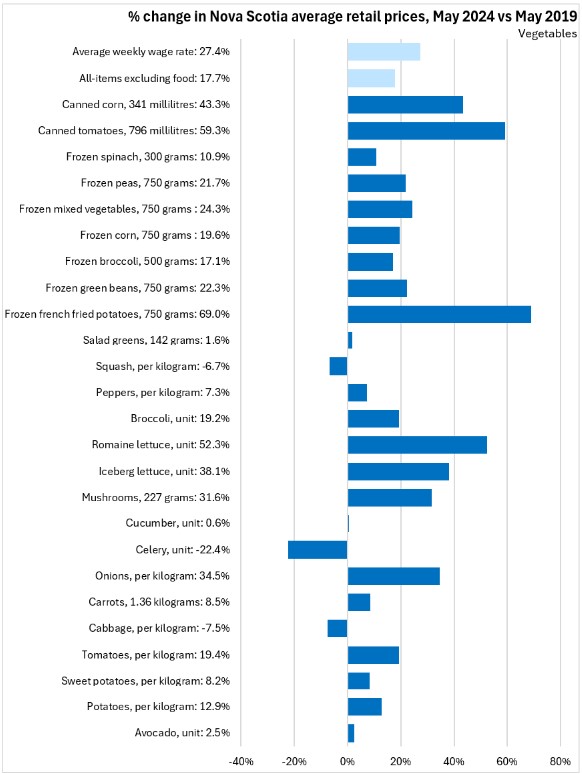
Nova Scotia prices for grain, cereal, nut, bean and legume products were higher than the national averages for all reported products except tofu.
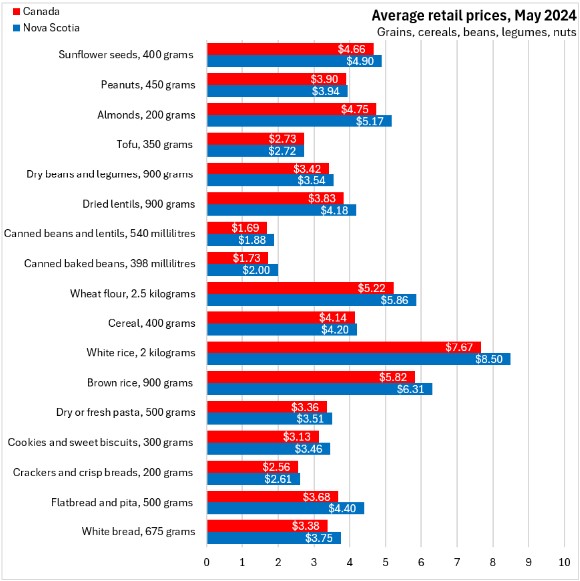
Over the last year, average weekly wages have grown faster than prices for all reported grain, cereal, nut, bean and legume products except canned baked beans. Several grain, nut, bean and cereal prices fell in Nova Scotia over the last year: sunflower seeds, almonds, dry beans/legumes, wheat flour, cereal, rice (white and brown), pasta, cookies, crackers, flatbreads and white bread.
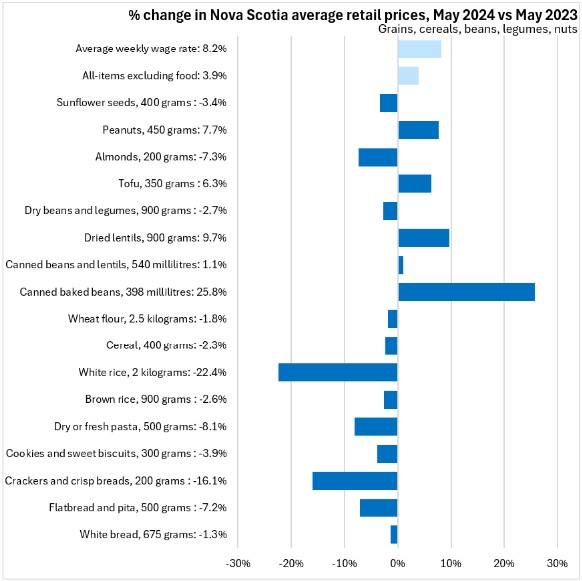
Over the last 5 years, prices for many reported grain, cereal, bean, legume and nut products have outpaced growth in average weekly earnings (excptions: sunflower seeds, peanuts, almonds, dry beans/legumes, canned beans/lentils, wheat flour, white rice, cookies and crackers.
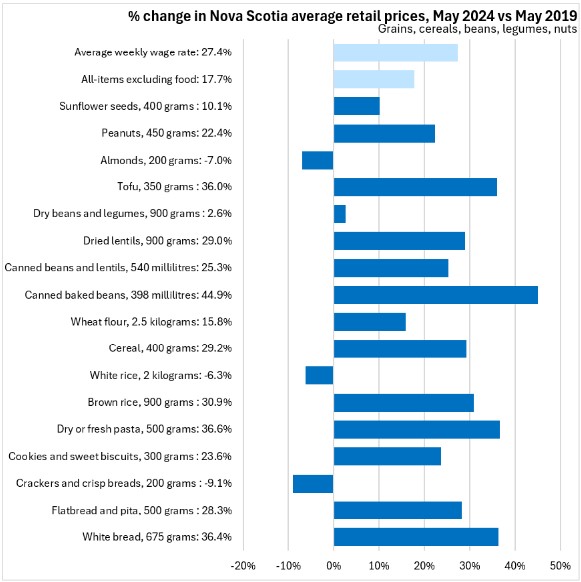
Among prepared foods, condiments, cooking oils, fruit juices and sugar as reported by Statistics Canada, only pasta sauces and salsa were less expensive in Nova Scotia than the national averages in May 2024.
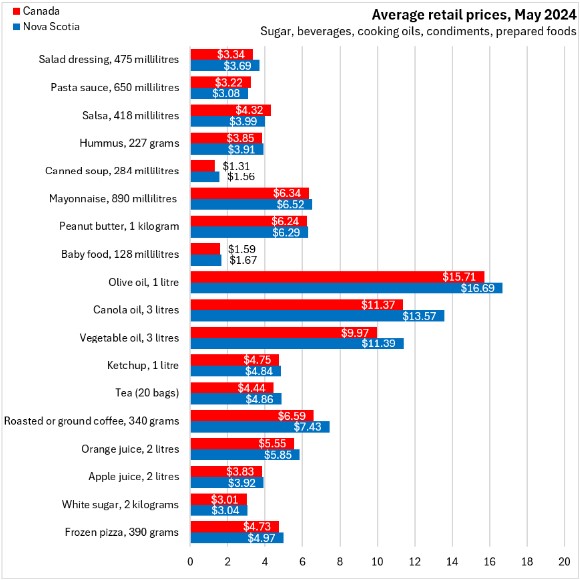
Prices for olive oil have risen sharply in the last year, well outpacing growth in average weekly earnings. Price growth also outstripped wage gains for frozen pizza, white sugar and orange juice. There were notable year-over-year declines in prices for salsa, canned soup, baby food, canola oil, vegetable oil, coffee and apple juice.
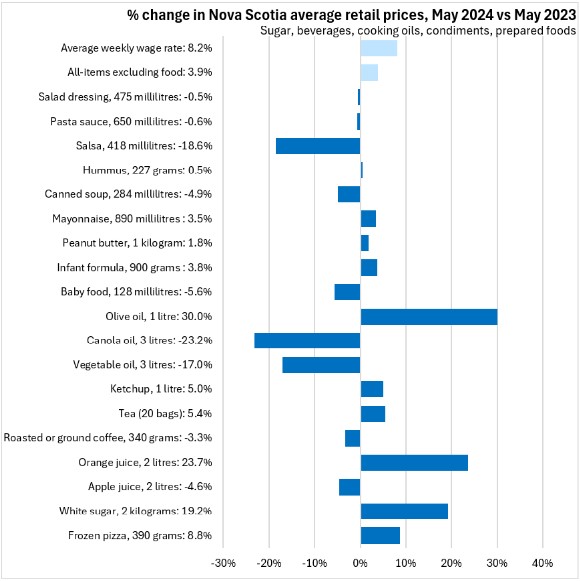
Over the last 5 years, prices for most reported foods in this category grew faster than average weekly earnings (exceptions: salsa, hummus, baby food, coffee, apple juice, frozen pizza).
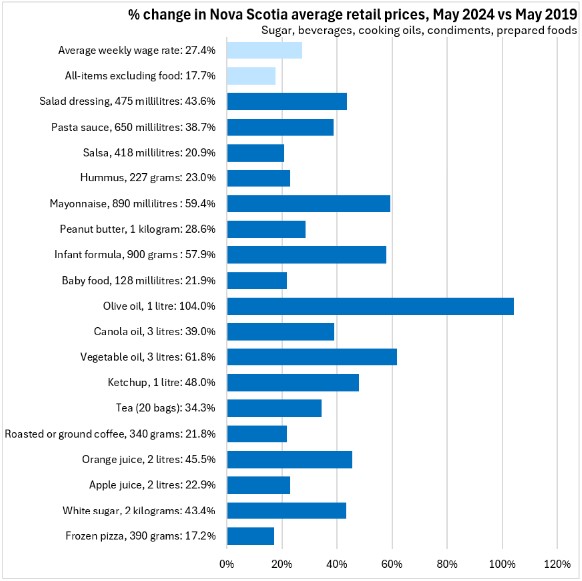
Of all products reported by Statistics Canada, infant formula (900 grams) has the highest transaction price based on the volume chosen. Nova Scotia infant formula prices were lower than the national average in May 2024.
Prices for health products (shampoo, toothpaste, deodorant) were higher in Nova Scotia than the national average, though the price of laundry detergent was lower.

Over the last year, prices for health and cleaning products did not grow as fast as average weekly wages. Laundry detergent prices were down substantially in Nova Scotia.

Over the last 5 years, all reported health product prices grew faster than average weekly earnings in Nova Scotia. However, the price of laundry detergent grew more slowly than Nova Scotia average weekly earnings.

Source: Statistics Canada. Table 18-10-0245-01 Monthly average retail prices for selected products; Table 18-10-0004-01 Consumer Price Index, monthly, not seasonally adjusted; Table 14-10-0063-01 Employee wages by industry, monthly, unadjusted for seasonality
|